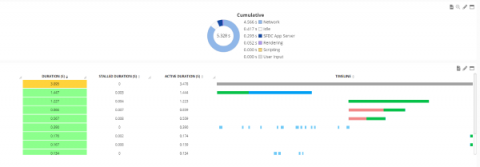Operations | Monitoring | ITSM | DevOps | Cloud
JavaScript
Deploy Friday: E83 Why is typescript taking over the world?
Troubleshoot Javascript (in real-time)
Javascript execution analysis on dev environments is easy—just use Google Developer or some other free tools. However, getting the same level of analysis while your application is being used by a real user is much harder. You can’t possibly ask the end-user to help you troubleshoot. Even if you did, the user probably wouldn’t know what to do and they definitely wouldn’t be impressed by your organization.
How to Get Started with JavaScript and InfluxDB
This article was written by Nicolas Bohorquez and was originally published in The New Stack. Scroll below for the author’s picture and bio. Telegraf is the preferred way to collect data for InfluxDB. Though in some use cases, client libraries are better, such as when parsing a stream of server-side events. In this tutorial, you’ll learn how to read a data stream, store it as a time series into InfluxDB and run queries over the data using InfluxDB’s JavaScript client library.
Add More Metadata to Your Front-end JavaScript Errors in AppSignal
Our front-end JavaScript library has been updated with an easier way to add more metadata to front-end errors using the sendError and wrap helpers. Previously, sendError and wrap helpers only supported customizing tags and the namespace for the error. More information could be set on error spans if they were manually created, but now that type of information can be added to errors sent using these helpers.
Instrumenting Our Frontend Test Suite (...and fixing what we found)
Here at Sentry, we like to dogfood our product as much as possible. Sometimes, it results in unusual applications of our product and sometimes these unusual applications pay off in a meaningful way. In this blog post, we’ll examine one such case where we use the Sentry JavaScript SDK to instrument Jest (which runs our frontend test suite) and how we addressed the issues that we found.
Clojure microservices for JavaScript developers part 2
This series was co-written by Musa Barighzaai and Tyler Sullberg. In the previous post, we explored high-level differences between thinking in Clojure compared to thinking in JavaScript. We are now ready to start building our first Clojure microservice. The microservice we are going to build will be very simple. It will be an HTTP server that uses a Redis data store to count how many times a given IP address has pinged the /counter endpoint.
Clojure microservices for JavaScript developers part 3
This series was co-written by Tyler Sullberg and Musa Barighzaai. This is the third and final post in a series of posts for JavaScript developers about how to set up Clojure microservices. The previous posts were: Those previous posts are useful context, but you can clone the repo and jump into this post without reading them.
Clojure microservices for JavaScript developers
This series was co-written by Tyler Sullberg and Musa Barighzaai. CircleCI is growing, which is wonderful. However, one of the growth challenges we have is that our backend is primarily written in Clojure, and few developers know Clojure. Many CircleCI engineers, including myself, have learned Clojure on the job. Before joining CircleCI, I was a JavaScript developer. As the lingua franca of software engineers, JavaScript is a relatively straightforward language to learn.
Javascript Pointers (They do exist!)
Javascript is often criticized for being a simple language, but if you take a closer look, there is actually a lot of nuance to it. For example, other languages often have pointers which are a way to store a reference to a specific place in memory. In C, Golang, and C# pointers are made using the ‘&’ operator. At first glance, there seems to be a conspicuous absence of this functionality for javascript.











